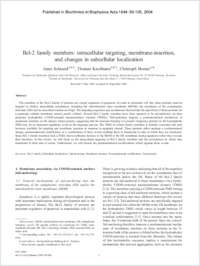Bcl-2 family members: intracellular targeting, membrane-insertion, and changes in subcellular localization
- Schinzel, Anna Institute for Molecular Medicine and Cell Research, Albert-Ludwigs-University Freiburg, Freiburg, Germany - Biochemistry Unit, Department of Medicine, University of Fribourg, Switzerland
- Kaufmann, Thomas Institute for Molecular Medicine and Cell Research, Albert-Ludwigs-University Freiburg, Freiburg, Germany - Biochemistry Unit, Department of Medicine, University of Fribourg, Switzerland
- Borner, Christoph Institute for Molecular Medicine and Cell Research, Albert-Ludwigs-University Freiburg, Freiburg, Germany
-
25.05.2004
Published in:
- Biochimica et Biophysica Acta (BBA) - Molecular Cell Research. - 2004, vol. 1644, no. 2, p. 95-105
Bcl-2 family
subcellular localization
tail-anchoring
membrane insertion
posttranslational modification
translocation
English
The members of the Bcl-2 family of proteins are crucial regulators of apoptosis. In order to determine cell fate, these proteins must be targeted to distinct intracellular membranes, including the mitochondrial outer membrane (MOM), the membrane of the endoplasmic reticulum (ER) and its associated nuclear envelope. The targeting sequences and mechanisms that mediate the specificity of these proteins for a particular cellular membrane remain poorly defined. Several Bcl-2 family members have been reported to be tail-anchored via their predicted hydrophobic COOH-terminal transmembrane domains (TMDs). Tail-anchoring imposes a posttranslational mechanism of membrane insertion on the already folded protein, suggesting that the transient binding of cytosolic chaperone proteins to the hydrophobic TMD may be an important regulatory event in the targeting process. The TMD of certain family members is initially concealed and only becomes available for targeting and membrane insertion in response to apoptotic stimuli. These proteins either undergo a conformational change, posttranslational modification or a combination of these events enabling them to translocate to sites at which they are functional. Some Bcl-2 family members lack a TMD, but nevertheless localize to the MOM or the ER membrane during apoptosis where they execute their functions. In this review, we will focus on the intracellular targeting of Bcl-2 family members and the mechanisms by which they translocate to their sites of action. Furthermore, we will discuss the posttranslational modifications which regulate these events.
- Faculty
- Faculté des sciences et de médecine
- Department
- Département de Médecine
- Language
-
- English
- Classification
- Biological sciences
- License
-
License undefined
- Identifiers
-
- RERO DOC 4354
- DOI 10.1016/j.bbamcr.2003.09.006
- Persistent URL
- https://folia.unifr.ch/unifr/documents/299543
Statistics
Document views: 166
File downloads:
- Texte intégral: 289
